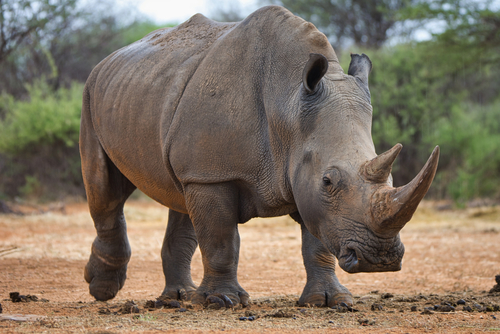
White Rhinoceros
Ceratotherium simum, or the white rhinoceros, is an imposing grazer of African savannas. Known for its wide mouth and social nature, it shapes the landscape, promoting biodiversity. Its majestic horn and hefty build distinguish it as an iconic symbol of wildlife conservation.
45-50 years
Lifespan
1440.0 - 3600.0 kg
Weight
Brown, Grey, Black
Color
30 mph
Top Speed
Near Threatened
Conservation Status
Decreasing
Population Trend
Characteristics
The Ceratotherium simum, commonly known as the white rhinoceros, is notable for its large size, wide mouth adapted for grazing, and prominent horn. Found in grasslands and savannas of Africa, this species is social, often forming groups. They play a crucial role in their ecosystem by shaping vegetation and influencing habitats.
Distribution Range of the White Rhinoceros
The species Ceratotherium simum, commonly known as the white rhinoceros, is native to Africa. Its geographical distribution primarily covers the southern part of the continent, including countries such as South Africa, Namibia, Zimbabwe, and Kenya. There are two subspecies: the southern white rhinoceros, which is found mostly in southern Africa, and the northern white rhinoceros, historically found in northeastern Africa, particularly in Uganda, Sudan, Chad, and the Democratic Republic of the Congo, though it is now considered extinct in the wild.
White Rhinoceros's Habitat
Environmental Conditions
White rhinoceroses typically inhabit savannas and grasslands, characterized by open spaces with grass and low shrubs. These areas are often located near water sources, as the species requires regular access to water for drinking and wallowing. The climate in these regions is generally warm, with seasonal variations in rainfall, influencing the availability of food and water.
Ecological Niche
White rhinoceroses are primarily grazers, feeding on short grasses prevalent in their habitats. They play a crucial ecological role in their environment by influencing the structure of the vegetation through their grazing habits, which helps maintain the savanna ecosystem. Their large size and grazing behavior also contribute to seed dispersal and create habitats for other species. The white rhinoceros is a keystone species, meaning its presence and behavior have a significant impact on the biodiversity and ecological balance of its habitat.
Copyright @ Nature Style Limited. All Rights Reserved.
 English
English